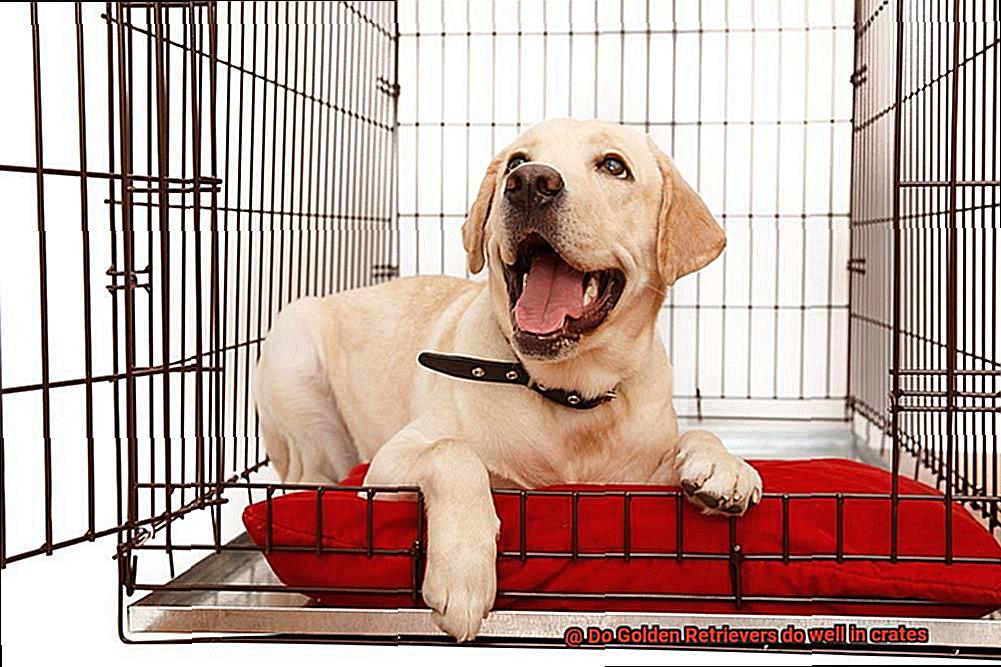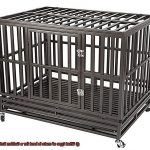Golden Retrievers are beloved all around the world for their kind, loyal, and intelligent nature. They make wonderful family pets and quickly become a cherished member of any household. But what happens when you need to leave your furry friend alone or take them on a trip? This is where the question of whether Golden Retrievers do well in crates becomes important.
Crate training is a popular practice among dog owners as it can aid in potty training and keep your pet safe while you’re away. However, not all dogs take to crate training easily, which can lead to stress and anxiety for both the pet and owner.
In this blog post, we’ll explore whether Golden Retrievers do well in crates and provide valuable information to help you decide what’s best for you and your furry companion. We’ll start by examining the benefits of crate training and why it may be an excellent option for your Golden Retriever. Then we’ll delve into factors that should be considered when crate training such as crate size, duration of confinement, and your dog’s personality. Finally, we’ll offer tips to ensure that crate training is a positive experience for both you and your furry friend.
So if you’re wondering whether Golden Retrievers do well in crates or looking for guidance on how to train your pup, keep reading. We’ve got everything you need to know right here.
Benefits of Crating a Golden Retriever
Contents
- 1 Benefits of Crating a Golden Retriever
- 2 How to Choose the Right Crate for Your Dog
- 3 Training Your Dog to Feel Comfortable in Their Crate
- 4 Tips for Keeping Your Dog Entertained While in Their Crate
- 5 Potential Drawbacks of Crating a Golden Retriever
- 6 Alternatives to Crates for Dogs Who Don’t Respond Well to Them
- 7 Conclusion
Golden Retrievers are known for their friendly and social personality, so it’s natural to feel hesitant about crating your furry friend. However, crating your Golden Retriever can provide several benefits for both you and your pet.
One of the primary advantages of crating your Golden Retriever is that it can help with house training. Dogs are naturally clean animals and prefer not to soil their sleeping area. By confining your Golden Retriever to a crate, you can encourage them to hold their bladder and bowels until they are let outside. This can speed up the house training process and save you from dealing with messy accidents.
Another benefit of crating your Golden Retriever is that it can prevent destructive behavior. As any Golden Retriever owner knows, these dogs love to chew on everything from shoes to furniture. By keeping your furry friend in a crate when you can’t supervise them, you can prevent them from causing damage to your home.
In addition to preventing bad behavior, crating can also provide your Golden Retriever with a safe and secure space of their own. As den animals by nature, dogs often seek out small spaces where they can feel protected and secure. By providing your Golden Retriever with a properly sized crate, you give them a place where they can relax and feel safe.
Finally, crating your Golden Retriever can be helpful when traveling or staying in new places. A familiar crate can provide your dog with a sense of comfort and security, even in unfamiliar surroundings. This can help reduce anxiety and stress for both you and your furry friend.
It’s important to remember that not all Golden Retrievers will take to crating right away. Some dogs may require additional training and patience from their owners before feeling comfortable in a crate. Additionally, make sure the crate is appropriately sized for your pet and provide plenty of toys and treats to keep them occupied and happy.
How to Choose the Right Crate for Your Dog
Choosing the right crate for your furry friend is an important decision that requires careful consideration. Here are five subtopics to consider when selecting the perfect crate for your Golden Retriever:
Size Matters
Your dog’s size plays a vital role in selecting the right crate. You want to ensure that the crate is not too small or too large. A crate that is too small can cause discomfort and anxiety, while one that is too large may not provide a sense of security. Measure your dog from nose to tail and add a few inches for comfort.
Materials
The material of the crate is another essential factor to consider. Plastic crates are lightweight and easy to clean, but may not be as durable as metal or wire crates. Soft-sided crates are great for travel but may not be sturdy enough for everyday use. Consider which material will best suit your dog’s needs.
Door Type
The type of door on the crate is also an important consideration. Some crates have doors that swing open, while others have doors that slide up and down. It’s crucial to choose a door type that your dog can easily navigate and that allows for easy access.
Additional Features
Think about any additional features that may be important for your specific situation. If you plan on using the crate for travel, look for one with handles or wheels for easy transportation. If you have a particularly anxious dog, look for a crate with a calming scent or one that provides extra insulation to reduce noise.

Consult with Your Vet
Finally, it’s always a good idea to consult with your veterinarian or a trainer if necessary to ensure you make the best choice for your furry friend. They can provide valuable insight into what type of crate will be the most suitable for your dog’s individual needs.
Training Your Dog to Feel Comfortable in Their Crate
Here are some helpful tips on how to train your Golden Retriever to love their crate.
Firstly, introduce the crate gradually. Leave the door open and place some treats inside. Allow your Golden Retriever to explore the crate at their own pace. This helps create positive associations with the crate.
Secondly, use positive reinforcement to encourage your Golden Retriever to enter the crate. Use treats or toys that they love and reward them when they enter the crate. This will help them understand that being in the crate is a good thing.
Thirdly, make sure the crate is comfortable for your Golden Retriever. Add a soft bed or blanket, and toys to keep them occupied. This will make the crate a cozy and comforting space for them.
Fourthly, start with short periods of time in the crate and gradually increase it over time. This will help your Golden Retriever get used to being in the crate without feeling overwhelmed.
Lastly, if your Golden Retriever whines or barks while in the crate, do not give attention or let them out of the crate. This will reinforce negative behavior and make training harder.

Tips for Keeping Your Dog Entertained While in Their Crate
There are times when you need to crate your dog for their safety or your peace of mind. The last thing you want is for your Golden Retriever to be unhappy or bored while in their crate. Fortunately, there are several ways to keep them entertained and comfortable.
Provide toys and treats
Golden Retrievers love toys, and providing them with interactive toys such as puzzle feeders or treat-dispensing toys can keep them occupied for hours. Additionally, chew toys are great for releasing pent-up energy and frustration. Just make sure to choose appropriate toys that won’t pose a choking hazard.
Use a Kong
Kongs are a favorite among dog owners and for a good reason. These durable toys can be filled with treats or peanut butter to keep your Golden Retriever busy while in their crate. Plus, they can withstand a lot of chewing, making them an excellent choice for this breed who loves to chew.
Play calming music

Dogs are social creatures, and being left alone in a crate can be stressful for some dogs, including Golden Retrievers. Playing calming music or white noise can help soothe your dog and make them feel more relaxed while in their crate. Choose a station with calming music or talk shows to help soothe them.
Practice crate training
Crate training is essential for helping your Golden Retriever become more comfortable with being crated. Start by introducing your dog to the crate gradually and using positive reinforcement techniques such as treats and praise to encourage them to enter the crate willingly. This will make the entire experience much more positive for your furry friend.
Rotate toys
Golden Retrievers are intelligent dogs that get bored easily. To keep them interested in their toys, rotate them regularly. This will prevent your dog from getting bored with the same toys and will keep them engaged and entertained.
Potential Drawbacks of Crating a Golden Retriever

Crate training can be an effective tool for potty training and keeping your pup safe, but it’s important to be aware of the potential drawbacks to ensure their happiness and well-being.
One potential issue with crating a Golden Retriever is boredom and anxiety. These social creatures thrive on human interaction and exercise, so being confined for extended periods can lead to destructive behaviors like chewing, digging, excessive barking, and whining. To prevent this, keep your pup entertained with interactive toys, Kongs filled with treats, and soothing music to make their crate experience more enjoyable.
Another drawback is negative associations with the crate. If your Golden Retriever views the crate as a form of punishment or confinement, they may become resistant or fearful of it. To avoid this, introduce the crate positively and never use it as a disciplinary tool. Make it a comfortable and inviting space, filled with cozy bedding and familiar toys.
Lastly, improper sizing and ventilation can lead to physical discomfort or health issues. Golden Retrievers are medium-sized dogs and require enough space to stand up, turn around, and lie down comfortably. Proper ventilation is also essential to prevent overheating and ensure good air circulation.
Alternatives to Crates for Dogs Who Don’t Respond Well to Them
However, not all dogs respond well to crate training, especially friendly and social breeds like Golden Retrievers. If this is the case for your pup, don’t fret. There are alternative solutions that can work just as well.
One option is a playpen. This enclosed area provides your dog with more room to move around and play than a crate. Additionally, you can leave toys, water, and food in the pen with your dog, keeping them entertained and comfortable while still contained.
Another option is to dedicate a dog-proofed room in your home. Select a small room and remove any potential hazards before setting it up with cozy bedding, toys, and water. This gives your furry friend more space to move around and can make them feel more comfortable than they would in a crate.
If anxiety or stress persists in their designated space, calming supplements or pheromone sprays can help reduce these feelings. These products work to soothe dogs and make them more willing to stay in their designated area.
It’s important to remember that every dog is unique, so what works for one may not work for another. It’s crucial to assess your Golden Retriever’s behavior and preferences before choosing an alternative to a crate. With patience and persistence, you’ll be able to find the right solution for you and your furry friend.
Conclusion
In conclusion, crate training can be a golden opportunity for Golden Retrievers when done correctly. It can help with potty training, prevent destructive behavior, provide a safe haven, and reduce anxiety during travel or new surroundings. However, it’s crucial to consider factors such as crate size, duration of confinement, and your dog’s personality before implementing crate training.
Selecting the right crate for your furry friend is not a trivial matter. The crate should be appropriately sized and made of durable material with a suitable door type. Additionally, consulting with your veterinarian or trainer can provide valuable insight into what type of crate will best suit your dog’s individual needs.
Training your Golden Retriever to feel comfortable in their crate requires patience and positive reinforcement. Gradually introduce the crate and use treats and praise to encourage them to enter willingly. Keeping your furry friend entertained while in their crate is also important with toys, Kongs filled with treats, calming music, and rotating toys.
While there are potential drawbacks to crating a Golden Retriever such as boredom and anxiety or negative associations with the crate, alternative solutions such as playpens or dog-proofed rooms may work just as well. Ultimately, every dog is unique; therefore assessing their behavior and preferences before choosing an alternative to a crate is crucial.









